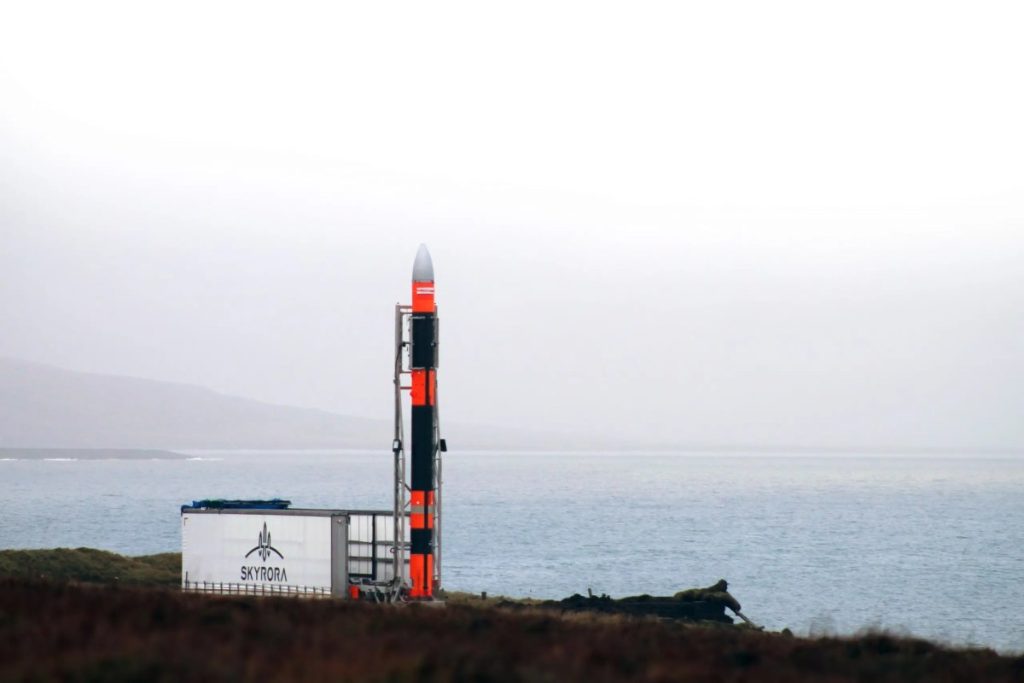
Skyrora eyes spring 2025 launch amid UK regulatory hangups (Image Credit: Space News)
TAMPA, Fla. — Scotland-based Skyrora hopes to launch its first suborbital mission from British soil in the spring following a year of regulatory delays.
It would be the second launch attempt for the company’s 11-meter-long Skylark L single-stage rocket, which fell 700 meters short of the Karman line after lifting off from Iceland in October 2022.
Skyrora pinned the failure on a software issue two months later and is eagerly awaiting another attempt to help de-risk Skyrora XL, a three-stage rocket twice as tall for placing payloads into orbits between 500 and 1,000 kilometers above Earth.
The company applied for a license from the U.K.’s Civil Aviation Authority in August 2022 to conduct spaceflight activities from Saxavord Spaceport, located in Scotland’s Shetland Islands, initially expecting it to take nine to 18 months to process.
But the CAA advised Skyrora in September 2023 to submit an additional license application for Skylark L, according to Alan Thompson, Skyrora’s head of government affairs.
As the original application dragged on, Skyrora first assumed it would have an easier time getting permission to launch a smaller, less powerful suborbital rocket from the spaceport.
“It’s actually within the parameters of the assessment of environmental effects that Saxavord already submitted,” Thompson told SpaceNews in an interview.
“So we thought, naively, that it would be easier.”
By April, he said Skyrora was not expecting to get the license until September. The company currently expects its application to be processed by mid-December for a suborbital launch in spring 2025.
New regulatory regime
SaxaVord became the first of a wave of vertical spaceports being developed in the United Kingdom to get a CAA license last year, allowing the spaceport to host up to 30 launches annually.
Germany’s Rocket Factory Augsburg had looked set to get a license to perform the first-ever vertical launch to orbit from British soil from the spaceport this year, but those plans went up in flames in a static-fire explosion.
The CAA “has only really got one cookie cutter and it’s for orbital launch,” Thompson said, adding “they can’t deviate from a process that they really are only getting to grips with right now.”
For the suborbital launch from the U.K., Skyrora also needs to complete a navigational risk assessment for the rocket’s projected splashdown off Scotland’s coast.
The U.K.’s Maritime Coastguard Agency oversees this assessment, covering what happens post-splashdown, such as how the rocket potentially breaks up and how the maritime environment would be affected whether the rocket is successfully recovered or not.
“We will need it to launch at the end of the day,” Thompson said, but “it’s like an ancillary license or an additional certification that we require to allow us to do that.”
Notably, he said MMO already has experience handling similar splashdown risk assessments, including one completed last summer for the German Offshore Spaceport Alliance (GOSA).
Orbital launch progress
Skyrora sees revenue potential from suborbital customers seeking to use Skylark L for up to six minutes of microgravity, ranging from academic research institutions to commercial technology developers.
The company’s inaugural U.K. flight also includes a proof of concept mission for a space telemetry provider to show how Skylark L could communicate with satellites.
Still, the company sees a bigger commercial opportunity for Skyrora XL, which would leverage the telemetry and onboard computing systems being engineered for Skylark L.
Thompson said Skyrora XL’s development continues apace despite Skylark L’s delays.
Although there are synergies between the two rockets, Skylark L’s main 30-kilonewton engine has a pressure-fed system while Skyrora XL’s 70-kilonewton engines use a turbopump.
Thompson said the company is close to completing tests for the last two of nine engines on Skyrora XL’s first stage, adding “we’ve got an engine test a week going on at the moment.”
He said Skyrora is also close to manufacturing Skyrora XL’s first stage and is preparing to integrate the engines for a vertical fire test by mid-2025.
Skyrora, which has development roots in the Ukraine, had hoped to perform the first vertical launch to orbit from British soil this year, according to the company’s latest public update Dec. 18.








